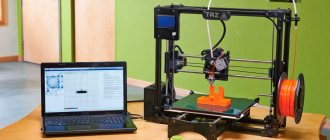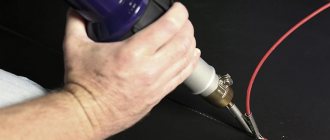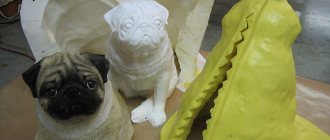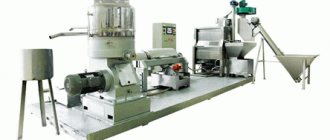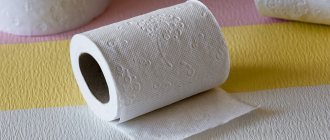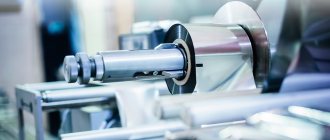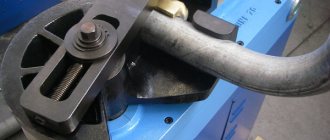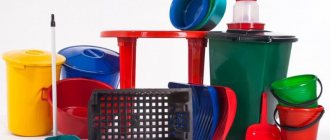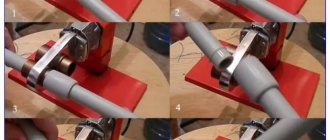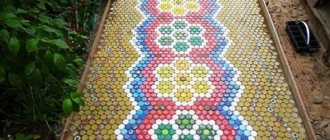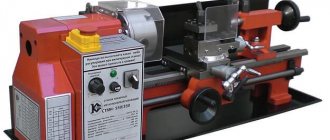0
Sheets and plates of thermoplastics are most often produced by calendering - rolling on multi-roll rolling machines. Corrugated sheets for honeycomb plastics are also produced by rolling on profile rolls. Shaped products from sheets are produced by pressing in dies using a rigid or elastic punch (an air-filled rubber bag).
The method of pneumatic and vacuum molding is widely used. In pneumatic forming, a sheet blank, heated to a plastic state, is clamped around the perimeter of the matrix, after which the blank is deposited onto the matrix using compressed air pressure. During vacuum forming, a vacuum is created inside the matrix, as a result of which the workpiece is drawn into the matrix, fitting its surface. This method is used to produce shaped lids, open tanks, fairings and other thin-walled products.
Pressing
Pressing is used for the manufacture of shaped products from thermosets and curable thermoplastics. The starting material is tablets, granules, crumbs; for products with powder fillers - press powders. The process is carried out in molds consisting of a matrix and a punch. Molding is carried out at elevated temperatures (the molds are heated), which ensures the hardening of the material.
A measured amount of preheated press material is poured into the matrix, after which a mechanical or hydraulic force is applied to the punch and the product is subjected to short-term holding in the mold under constant pressure, resulting in the material hardening. Then the punch is retracted; and the hardened product is removed from the matrix by ejectors.
Molding modes (preheating temperature, pressing temperature and pressure, holding time) depend on the formulation of the pressing material, the size and configuration of the product and are selected experimentally. Typically, the preheating temperature is 130–180°C, the pressing temperature is 200–220°C, the pressing pressure is 10–30 MPa, and the holding time is 15–30 s.
Currently, fully automated multi-position rotary pressing units with automatic high-frequency heating are used, the productivity of which is 100 pressings per minute and above.
The accuracy of the dimensions of the part depends on the accuracy of the manufacture of the matrix and punch, the accuracy of dosing the press material and on compliance with the pressing conditions.
The surface quality of the parts is high. With proper finishing of the forming surfaces of the matrix and punch (chrome plating, polishing), it is possible to obtain a surface with a roughness of Ra = 0.080–0.160 μm.
Molding of plastics into silicone - affordable small-scale production at home
Many of those who print on a 3D printer are faced with either the need to receive a batch of models in a short time, or to copy a successful part, or to obtain products with strength characteristics that exceed those of plastics for home 3D printing. A 3D printer is not always capable of performing such tasks, but it is perfect for creating a single sample, or master model. And then materials produced by Smooth-On, probably the most popular manufacturer of cold-curing materials, come to our aid.
In this review, we will compare the most basic and popular silicones, polyurethanes and additives to them, take a brief look at the main methods of creating molds and products, think about where this can be used and, finally, create your own silicone mold and model. Before writing this post, we completed a three-day training at the official Smooth-On dealer in Russia to understand all the intricacies of silicone casting.
Process overview
The process of creating products using the casting method is almost always the same: we create a model, use it to create a silicone mold, fill it with material, and get a product. But depending on the model, the required properties, and the number of castings, each stage can change dramatically. There are several ways to both create the mold and the finished product.
A few words about preparing 3D printed models. The company Smooth-On turned its attention to this technology and released a special varnish called XTC-3D. It perfectly smooths out the blemishes characteristic of printed models, visible layers that will definitely transfer to the silicone mold, and gives the surface a smooth and glossy appearance. You can read a detailed review of XTC 3D here.
Methods for creating forms
• Solid fill
The easiest way: the model is placed in formwork (a special sealed container made of ordinary plexiglass, plastic or other material), fixed in it and filled with silicone. Well suited for simple two-dimensional models, reliefs, souvenirs and branding products.
• Split shape
Similar to the previous one, only the model is placed taking into account that the form will be cut completely or partially to facilitate removal. The model can be suspended with wire or placed on a thin support. The method is intended for more complex geometry, technical products, and complex shapes.
• Two-piece form
This is one of the most difficult methods. It involves placing the model on a clay or plasticine base, which divides the silicone mold in half.
Special locks are placed on the base, which will ensure precise alignment of the two shapes and no displacement. The formwork is assembled around the base, sealed with hot glue or plasticine, and the first half of the mold is poured into it. Then, after the silicone has cured, the mold is turned over, the clay or plasticine is scraped off, the silicone is coated with a release agent, and the other half of the mold is poured.
• Spread method
This method creates so-called “stocking” molds, when silicone exactly follows the shape of the object and has a thickness from 3 mm to several centimeters. To create a “spreadable” mold, you need sufficiently viscous silicone that does not flow off the model. You can use either silicones specially designed for this purpose, called thixotropic, or regular ones, but modified with thickeners.
The silicone is applied with a brush or spatula in several layers, alternating viscosity and curing speed to ensure the shape is as detailed and durable as possible. Once all the layers are ready, a special compound is used to create a hard outer shell that will hold its shape.
Plastic pouring methods
The simplest method is simply pouring plastic into a mold; it is suitable for home use and allows you to achieve acceptable quality. But, if necessary, for a better result, it is possible to use high-pressure units, which will almost completely remove air bubbles.
To do this, the mold, together with the filled plastic, is placed in a chamber in which a pressure increased to 4 atmospheres is created. The mold must remain in the chamber while the polyurethane is curing. With this pressure, the bubbles are reduced to sizes almost invisible to the eye, which significantly improves the quality of the product.
Another method, the so-called run-in casting, is used to create hollow products. A small amount of plastic is poured into the mold, about 10% of the total volume, the filling hole is closed, and the mold begins to rotate along all planes, manually or on a special rotary machine. In this case, the plastic hardens on the walls of the mold, creating a hollow model, which can significantly reduce the weight of the product and save material.
Overview of silicones
• Mold Star Series 15, 16, 30 Silicones for creating molds based on platinum. They cure at room temperature and form a strong, flexible and highly detailed shape. Designed for casting silicone, polyurethane, resins, polyester, wax and other materials. Chemically sensitive and unable to work with latex, sulfur and some other compounds. The most basic and basic silicones, capable of solving most problems. The number in the name reflects the hardness on the Shore A scale. It has low viscosity, which allows in most cases to work without degassing equipment. The material is two-component, the parts are mixed in a convenient ratio of 1:1 by volume. Mainly intended for creating forms using continuous filling.
• Rebound 25, 40 series A series of silicones for creating molds using the “spread on” method, which consists of applying silicone with a brush or spatula to the surface of the model. It has high viscosity and the ability to modify properties using thickeners and accelerators to create a high-quality multilayer form. Two-component, mixed in a 1:1 ratio by volume.
• Equinox 35, 38, 40 series Silicone pastes with a lifetime of 1, 4 and 30 minutes. Designed for manual mixing, the consistency resembles thick dough. The numbers correspond to Shore A hardness. It has extremely high tensile strength and durability. When cured, it is safe for pouring chocolate, caramel and other ingredients.
• SortaClear Series 18, 37, 40 Series of translucent silicones. A feature such as optical transparency is used to create complex cut shapes - the product is perfectly visible, which allows you to make an accurate cut. Like the Equinox series, it is safe in contact with food. There are also a large number of additives for silicones that have a variety of effects. Accel-T and Plat-Cat are curing accelerators, Slo-jo - increases the life of silicone, Thi-Vex increases the viscosity of silicone and allows you to spread it with a brush or spatula on the model, Silc-Pig - these are concentrated pigments for painting.
Review of polyurethanes
• Smooth-Cast Series The most basic and popular series of polyurethanes for creating final products. The line includes more than 10 types of different plastics with a variety of properties, allowing you to choose the material specifically for your project. For example, Smooth-Cast 300 has a short pot life of 3 minutes and a cure time of 10 minutes, allowing you to quickly reproduce large batches of parts. Smooth-Cast 305 is similar to the previous one, but it “lives” for 7 minutes, which allows you to degas mixed components and get an even better product. ONYX has a deep black color that cannot be achieved with dyes, 65D ROTO is designed for creating hollow models using the “break-in” method, 325 is indispensable for accurate color reproduction, 385 cures with virtually no shrinkage and copies the product as accurately as possible.
• TASK Series A series of special-purpose polyurethanes. Designed for industrial use and has specific properties for specific tasks. For your convenience, we have created special filters by area of application:
• Food grade: Smooth-Sil 940, Sorta Clear series, Equinox series, TASK 11.
• Architectural, pouring concrete and other abrasive materials: VytaFlex Series, Brush-On Series, Ez-Spray Series, PMC Series.
• Medical: simulation of tissues and organs Dragon Skin Series, Slacker additives, Ecoflex 0030, Ecoflex Gel, Body Double.
• Prototyping: Almost any polyurethanes and silicones, depending on the tasks and requirements. Series Mold Max, Mold Star, Smooth-Cast, TASK.
• Special effects and makeup: Skin Tite, Body Double, Dragon Skin, Alja-Safe, Ecoflex, Soma Foama, Rubber Glass, Encapso K. It is worth noting that this division is still conditional, and is given to roughly imagine the capabilities of the wide range of the Smooth company -On.
Process overview
We will only use materials and equipment that can be used at home. We will try to create the most difficult two-part mold to manufacture.
We will need: • Platinum silicone Mold Star 30 • Polyurethane casting Smooth-Cast 300 • Varnish for 3D models XTC-3D • Pack of vinyl gloves • Several disposable plastic cups • Mixing containers • Hot glue gun • Formwork material (plastic panels) • Sculpting clay • Several paint brushes
The master model will be a model of a test bolt that is quite popular among printers. We printed it with black PLA plastic on Picaso 3D Designer with a layer thickness of 100 microns. We did this specifically to demonstrate the effect of XTC 3D, since not every 3D printer can print with a quality of 50 microns.
Next is processing so that the cast model does not take on the layering of the printed object. We treat the bolt with XTC-3D varnish (you can read more about this process here), and then sand it to get a smooth matte surface.
Now the model is ready to be filled with silicone. We place it on a clay base, with which we will create a silicone mold of two parts.
The model should be exactly half immersed in the clay, so we begin the process of leveling the clay. The edges should be as smooth as possible and completely adjacent to the model; the quality of separation of the silicone halves depends on this. We remove excess clay and enclose the model in plastic formwork.
We process all plastic joints with a hot glue gun and close the formwork, finally process the clay base, and make recesses in it for locks.
Everything is ready to pour silicone. Since two-component silicones and polyurethanes tend to separate into fractions, they must be thoroughly mixed in a container before each use. After mixing, measure out equal amounts of the two components by volume and begin mixing.
For this brand of silicone, degassing in a vacuum chamber is not necessary, which is very convenient: the appearance of bubbles that can ruin our shape is eliminated. Slowly pour silicone into the formwork, to its lowest point.
And leave it to harden. The curing time for this brand of silicone is 6 hours. After this time, we free the model from the formwork.
Then we remove the clay, thoroughly clean the model from its remains, and lubricate the silicone with a release agent. If it is unavailable, you can use regular Vaseline, but the quality will be slightly worse.
And then we repeat the process completely, filling the second half of the silicone mold.
After another 6 hours, the silicone mold is ready. Using a blade, we carefully separate the halves, take out the part and evaluate what we have done.
The locks that were laid in the clay base are clearly visible, there is good detail, despite the fact that the dividing line ran through rather difficult places, such as depressed letters.
In fact, for this model this is not the most optimal way to create the form. But we were interested in testing this particular method, despite the difficulties.
So, everything is ready to pour polyurethane. We connect the two halves of the form using formwork elements for rigidity, fasten them with rubber bands, tape or another method, and proceed to prepare the polyurethane.
Mix both components well, shaking them for 5-10 minutes. After this, let it sit for a while so that the bubbles that have formed come out. Everything else is exactly the same as with silicone: measure out equal amounts by volume and mix them. And then you need to act quickly: the lifetime of this polyurethane is only 3 minutes, and time begins to tick as soon as you mix the two components together. So we stir quickly, but carefully, so as not to create unnecessary bubbles, and immediately pour it into the mold.
After about 3 minutes, depending on the volume of material, the plastic will quickly set, and after 10 minutes the part is ready for removal.
The model is ready. Absolutely all details of the original are transferred.
Conclusion
I would like to note that the use of Smooth-On materials in combination with 3D printing opens up truly enormous possibilities. Now you can produce products from a huge number of materials with a wide variety of properties, and not be limited to just classic PLA and ABS. In addition, small-scale production will become available: by printing just one copy and properly processing it, you will be able to create the number of copies you need at home in a fairly short time. To achieve an acceptable result, it is not at all necessary to use expensive equipment.
If you need small-scale production services, Top 3D Shop is at your service.
Injection molding
Injection molding is used to mold thermoplastics. The starting material (granules, tablets) is heated until completely softened. The casting mass of a fluid consistency is fed into a heated cylinder, from where it is extruded by a piston through the gating channels into cooled metal molds. Once cooled and solidified, the mold is opened and the castings are removed using ejectors. The sprues and burrs formed in the mold parting cavity are cut off and cleaned. The softening temperature of the casting mass depends on its composition. Pressure 100-150 MPa. Mold temperature 20-40°C.
Injection molding is more productive and produces higher, more consistent product quality than pressing. It is possible to obtain a surface with a roughness of Ra = 0.02–0.04 µm.
Modern injection molding machines with multi-position molds and a fully automated workflow have a capacity of up to 200 castings per minute.
To eliminate internal stresses and increase the homogeneity of the structure, the castings are subjected to normalization: heating without access of air (usually in mineral oil) at 140-160°C for 1.5-2 hours, followed by slow cooling.
How to start production: step-by-step instructions
To implement a project, draw up a competent guide to action.
Include the following sections in your business plan:
- analysis and summary of ideas;
- registration and paperwork;
- production plan; financial plan; sales channels; marketing and advertising.
Let's look at the basic points of the plan in more detail.
Analytics
Conduct an analysis before starting a project. Explore the domestic market in the region. Find out how in demand plastic goods are in your city, and if there are analogue enterprises. If there are competing factories, evaluate the real business prospects and develop your own concept. Think over your competitive advantages - this will help you take your place in the market. Study the cost of equipment and assess your financial capabilities. At this stage, it is easy to abandon the project if data analysis shows high business risks.
Registration
If the business concept does not involve large-scale production, register as an individual entrepreneur. The period during which the certificate will be issued is only three working days. The fee is 800 rubles, you can register an individual entrepreneur online for free. Accounting reporting - to a minimum.
Required documents:
- statement;
- TIN code;
- passport;
- duty payment receipt.
After registration, you need to open a bank account.
If the business is aimed at further expansion, modernization of production and entering the market outside the region, it is better to immediately register an LLC.
Advantages:
- you can have co-founders;
- work with legal entities;
- receive a tax refund.
The package of documents stated above will require the charter of the organization. The state duty is 4,000 rubles.
The next step is tax registration. Contact the branch at your place of registration and submit the appropriate application. Specify the tax form. Choose the simplified tax system at a rate of 6% of income or 15% of the difference between investments and profit.
The following are available as OKVED activity codes:
22.29 - production of plastic products; 32.40 - production of children's products made of plastic.
Please note! When working with polymers, the material releases toxic substances.
To avoid harm to the environment, comply with sanitary, environmental and fire requirements. Violation of them is subject to large fines, including the closure of production.
All goods must have certificates of compliance with GOST requirements, especially when it comes to toys and plastic utensils.
Extrusion
Extrusion molding is used for the production of rods, pipes, hoses, plates, films, and shaped profiles (handrails, baseboards, etc.) from thermoplastics. The process is carried out on continuous screw presses (extruders). The casting mass is fed through the loading hopper into a heated screw cylinder, picked up by the turns of the screw (which in turn is heated) and moves along the cylinder, undergoing mixing and compaction. Compaction of the mass is achieved by reducing the pitch or height of the auger turns. A die with a hole corresponding to the cross-sectional shape of the product is installed at the outlet end of the cylinder. The molded product, emerging as a continuous strand from the die, is cooled. After hardening, it is cut into pieces of the required length.
Recently, heat resulting from friction of the mass against the cylinder walls and screw turns (“adiabatic extrusion”) has been used to heat the casting mass. This method simplifies the design of the press and increases the efficiency of the process.
The extrusion method is widely used for applying insulating sheaths to conductors, cables, etc. The conductors to be coated are fed from the coil through the central hole in the screw and are enveloped in the molding mass in the die.
To produce films, an angular head is installed at the output end of the press. The workpiece leaves the die in the form of a thin-walled pipe, is rotated at an angle of 90°, inflated with compressed air until the walls of the required thickness are obtained, and enters a wedge-shaped gap between two endless belts, where it is flattened. The resulting double tape is fed by exhaust rollers for cutting.
From pipes obtained by extrusion, hollow products (flasks, bottles, flasks, etc.) are made (by blowing in molds). The bottom of the products is welded.
Molding of fiberglass plastics
Small-sized fiberglass products are produced by hot pressing in metal molds. This method is not applicable for the manufacture of large-sized products, since it requires powerful pressing equipment and the production of expensive and bulky molds.
Large-sized shell structures are most often made by spraying plastic into a viscous-flowing state along with glass fiber onto the model. Plastic and chopped fiber are fed in the required proportion into the sprayer. The stream emerging from the sprayer is applied to the model until a layer of the required thickness is formed.
Positive models, which reproduce the internal contour of the product, are used in cases where it is necessary to obtain a smooth and precise internal surface. Negative models, which reproduce the outer contour of the product, are used to obtain a clean and accurate outer surface.
When making products from cold-curing plastics, models are made from wood, gypsum, cement, and also from thermosetting plastics. During hot curing, metal heated models are used. The surface of the layer applied to the model is compacted by rolling with rollers or crimping with compressed air through an elastic cover made of heat-resistant rubber or elastic silicone plastic. After curing, the surface of the product is cleaned, primed and coated with finishing synthetic varnish.
The dimensional accuracy of products produced by the spraying method is low. For large parts, the difference in size can reach several millimeters. The strength of such products is inferior to the strength of products pressed under high pressure.
To manufacture hollow parts in the shape of bodies of rotation (pipes, cones, etc.), the method of winding continuous strands of glass fiber impregnated with synthetic on a rotating mandrel is used. The spinner feeder is mounted on a support that performs a reciprocating movement relative to the mandrel. Winding is usually done crosswise in several layers. The wound layers are compacted with rollers.
When producing high-strength boards with oriented fiber, winding is done on a large-diameter drum, the still unhardened winding is cut along the generatrix, straightened and pressed in flat or shaped dies.
Equipment for the production of plastic products
Standard set of equipment for opening a workshop for the production of plastic goods:
- melting unit;
- device for loading and feeding polymer sheets;
- pressing molds;
- refrigeration equipment;
- bending apparatus;
- stripping unit;
- gluing machine;
- line for painting and drawing;
- line for packaging finished products.
Additionally, you can purchase a 3D printer. The device has a high printing speed and allows you to realize almost any idea. It's easy to work with. The only drawback of the printer is low performance. For large-scale production the thing is useless, but for individual orders it’s just right.
You can choose between domestic or foreign equipment. Start from your financial capabilities. Machines from Europe will last much longer, but will also cost 2-3 times more. By the way, among Russian manufacturers you can also find high-quality lines for processing plastic. But it is better to refuse Chinese automatic lines - they often break down and are expensive to repair.
Welding of plastics
Thermoplastics of all types lend themselves well to welding. Highly elastic plastics (polyolefins, polyamides, polymethyl methacrylates) are welded by resistance welding without the use of filler material. Thin sheets and films are overlap welded by passing the films between rollers heated by electric current. Plates, bars and other similar products are butt welded. The surfaces to be welded are compressed under a pressure of 0.1-0.3 MPa; the joint is heated with high frequency currents or ultrasound. The strength of the welded joint is close to the strength of the material itself.
Plastics with less plasticity (vinyl plastics, fluoroplastic) are welded using a filler rod made from the same material as the parts being welded, but with the addition of a plasticizer. The edges to be joined are cut to form a weld pool. Welding is performed with a jet of hot air. The strength of the weld is 70-80% of the strength of the material itself.
Methods for welding thermosetting and hardening plastics, as well as fiberglass, have also been developed.
Plastics are well bonded using adhesives, which are a solution of a given polymer in an appropriate solvent. Some adhesives (polyvinyl acetate, phenol-neoprene, based on modified epoxides, etc.) have wide versatility in relation to the materials being glued. These adhesives can be used to bond plastics to metal, glass, ceramics, etc.
Manufacturing of plastic products - types of products
The scope of use of plastic as a material has virtually no restrictions. This is an additional argument in favor of business.
Potential clients of the production plant:
- plastic goods are:
- agricultural industry;
- medical institutions;
- construction companies;
- automobile enterprises.
The most popular types of products:
- packages;
- disposable tableware;
- bottles and other containers for drinks, household chemicals, hygiene products;
- buckets, basins, water tanks;
- containers for food and household items;
- children's assortment - toys, dishes;
- spare parts for cars;
- linoleum;
- construction fasteners;
- equipment for playgrounds, leisure and entertainment centers, schools and kindergartens.
